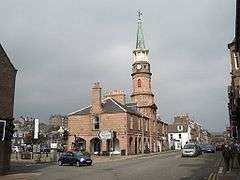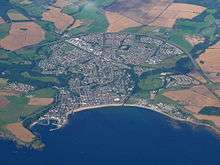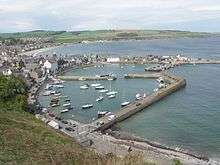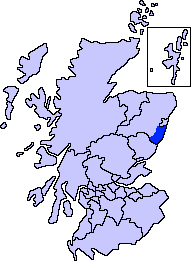Stonehaven
| Stonehaven | |
| Scottish Gaelic: Cala na Creige | |
| Scots: Steenhive | |
| Stoney | |
 Market Square, Stonehaven |
|
 Stonehaven |
|
| Population | 11,602 (Scotland's Census 2011)[1] |
|---|---|
| OS grid reference | NO8786 |
| Council area | Aberdeenshire |
| Lieutenancy area | Kincardineshire |
| Country | Scotland |
| Sovereign state | United Kingdom |
| Post town | STONEHAVEN |
| Postcode district | AB39 |
| Dialling code | 01569 |
| Police | Scottish |
| Fire | Scottish |
| Ambulance | Scottish |
| EU Parliament | Scotland |
| UK Parliament | West Aberdeenshire and Kincardine |
| Scottish Parliament | Angus North and Mearns |
Coordinates: 56°57′50″N 2°12′40″W / 56.964°N 2.211°W
Stonehaven (![]() i/stoʊnˈheɪvən/; [stinˈhaiv]) is a town in Aberdeenshire, Scotland. It lies on Scotland's northeast coast and had a population of 11,602 (Scotland's Census 2011).[1]
After the demise of the town of Kincardine, which was gradually abandoned after the destruction of its Royal castle in the Wars of Independence, the Scottish Parliament made Stonehaven the successor county town of Kincardineshire. Stonehaven had grown around an Iron Age fishing village, now the "Auld Toon" ("old town"), and expanded inland from the seaside. As late as the 16th century, old maps indicate the town was called Stonehyve, Stonehive, Pont also adding the alternative Duniness.[2] It is known informally to locals as Stoney.
i/stoʊnˈheɪvən/; [stinˈhaiv]) is a town in Aberdeenshire, Scotland. It lies on Scotland's northeast coast and had a population of 11,602 (Scotland's Census 2011).[1]
After the demise of the town of Kincardine, which was gradually abandoned after the destruction of its Royal castle in the Wars of Independence, the Scottish Parliament made Stonehaven the successor county town of Kincardineshire. Stonehaven had grown around an Iron Age fishing village, now the "Auld Toon" ("old town"), and expanded inland from the seaside. As late as the 16th century, old maps indicate the town was called Stonehyve, Stonehive, Pont also adding the alternative Duniness.[2] It is known informally to locals as Stoney.
The town is served by Stonehaven railway station, and lies just to the east of the A90 road.
History
Stonehaven is the site of prehistoric events as witnessed by finds at Fetteresso Castle and neolithic pottery excavations from the Spurryhillock area.[3] The town lies at the southern origin of the ancient Causey Mounth trackway, which was built on high ground to make passable this only available medieval route from coastal points south to Aberdeen. This ancient passage specifically connected the Bridge of Dee to Cowie Castle via the Portlethen Moss and the Stonehaven central plaza.[4] The route was that taken by the Earl Marischal and Marquess of Montrose when they led a Covenanter army of over 9000 men in the first battle of the English Civil War in 1639.[5] Originally the settlement of Stonehaven grew and prospered and was known as Kilwhang. With 'Kil' meaning hill and 'whang' the name, or sound of a whip, possibly, the name is derived from the cliffs above the original settlement and the sound of wind whistling around their meagre shelters.
The Covenanters were imprisoned in Dunnottar Castle, where many died. A memorial to them can be found in Dunnottar Church. Other castles in the vicinity are Fetteresso Castle and Muchalls Castle, both of which are in private ownership and not open to the public. The oldest surviving structure in Stonehaven is the Stonehaven Tolbooth at the harbour, used as an early prison and now a museum.
Dunnottar Castle, perched atop a rocky outcrop, was home to the Keith family, and during the Scottish Wars of Independence, the Scottish Crown Jewels were hidden there. In 1296, King Edward I of England took the castle only for William Wallace to reclaim it in 1297, burning down the church in the process with the entire English garrison still in it. In 1650, Oliver Cromwell sacked the castle to find the Crown Jewels following an eight-month siege (having previously destroyed the English Crown Jewels). However, just before the castle fell, the Crown Jewels were smuggled out by some ladies who took them by boat to a small church just down the coast in the village of Kinneff, where they remained undetected for eleven years.
Stonehaven was a Jacobite town in the Fifteen and it was a safe base for the retreating Jacobite army to stay overnight on the night of 5–6 February 1716. In the Forty-Five Stonehaven, part of the Episcopalian north-east, was again ‘reliably Jacobite’ and it was one of the north-eastern ports where reinforcements, plus money and equipment were periodically landed from France.[6]
Near the Cowie Bridge, at the north of Stonehaven, was a fishing village known as Cowie, which has now been subsumed into Stonehaven. Somewhat further north are the ruins of Cowie Castle. Slightly to the west of Stonehaven is the ruined Ury House, originally a property of the Frasers.

A fossil of the oldest known land animal, Pneumodesmus newmani, a species of millipede, was found at Stonehaven's Cowie Beach in 2004.[7][8]
Geography

Stonehaven is 15 miles (24 km) south of Aberdeen in a sheltered position on Stonehaven Bay between the Carron Water and the Cowie Water. Stonehaven lies adjacent to a deeply indented bay surrounded on three sides by higher land between Downie Point and Garron Point. The harbour, consisting of two basins, was improved in the 1820s by the engineer Robert Stevenson (grandfather of the author Robert Louis Stevenson) and became an important centre of the 19th century herring trade;[9] the harbour is bordered on the north by Bellman's Head and at the south by Downie Point. At the western edge of Stonehaven west of the A90 road lies the village of Kirkton of Fetteresso. Nearby to the south, Fowlsheugh is a coastal nature reserve, known for its seventy metre high cliff formations and habitat supporting prolific seabird nesting colonies.
Stonehaven has grown rapidly since the oil boom in Aberdeen. The increasing demand for new, middle-class housing has seen four new estates being appended to the town, creating an expanse of suburbs and Stonehaven has been bypassed since 1984.
Because of its location at the confluence between two rivers, Stonehaven is prone to flooding following heavy rain.[10][11] Aberdeenshire Council has held meetings about the possible construction of flood defences.[12]
Places of worship
Stonehaven has three Churches of Scotland: Dunnottar Parish Church, Stonehaven South Parish Church and Fetteresso Parish Church, an evangelical Church of Scotland. The town is also home to City Church South, Stonehaven Baptist Church, St James' Episcopal Church and St Mary's Catholic Church.
Educational establishments
Primary schools
- Arduthie Primary School is one of the three primary schools in Stonehaven serving a large portion of the north and east of the town as well as the surrounding countryside to the north-west.[13]
- Dunnottar Primary School Was founded in 1889. is linked to the notable parish Church and to the historic Dunnottar Castle and is located at the edge of the old town. It serves the old town and the majority of the countryside surrounding Stonehaven[14] As part of the Stonehaven flooding in 2009 the school was affected and pupils had to be relocated for a week while work was undertaken.
- Mill O' Forest Primary School, is located in the newer part of Stonehaven and serves the south and parts of the north of the town.[15]
Secondary schools
- Mackie Academy is the town's secondary school and was originally founded at the site occupied currently by Arduthie School. Mackie takes pupils from a relatively large chunk of Southern Aberdeenshire with its catchment zone stretching from Johnshaven in the south to Netherley in the North and out to Glenbervie in the West.
Special Needs Schools
- Carronhill School is a special needs school located within the town.
Commerce and culture

Historically the chief commerce of Stonehaven lay in fishing. Led by the herring fishery, the catch peaked around the year 1894 with a peak catch of about 15 million fish per annum and an employment in the fishing industry of 1280 people. Due to overfishing to serve the expanding regional population, the fishing industry declined with diminishing catches, such that by 1939 only a remnant of the earlier fishing fleet continued to exist,[5] and the catch mostly supported the local population from that point onward.
At present day the town's primary industries are marine services and tourism, with Dunnottar Castle, a local landmark, bringing in a large number of tourists every year. Dunnottar Castle is regularly used in promotional material by the Scottish tourism industry; in addition, it was used in the 1990 movie Hamlet, and appeared as a featured desktop background in the UK edition of Microsoft Windows 7. Another attractive feature of the town is the long beach facing the North Sea, with large cliffs at either end sheltering small rock pools and inlets. It is also famous for its olympic-sized outdoor swimming pool, which is heated and filled with a mixture of tap water and filtered seawater. The local harbour features the Tolbooth, the town's small museum of local heritage.

During Hogmanay festivities, the High Street comes alive with crowds watching the annual fireballs ceremony, in which volunteers walking down the High Street swing huge balls of fire around and around at the ends of chains. The Fireball Festival was part of the content of STV's Hogmanay coverage. The fireballs are finally thrown into the harbour.[16] Stonehaven's long established pipe band plays at events throughout the year, including the folks festival and fireball ceremony. The band has competed at various levels throughout its illustrious history including several years at the prestigious Grade 1.
The town's Haven Fish Bar was the likely origin of the Deep-fried Mars Bar,[17] a snack now culturally associated with Scotland - and its health record - as a whole. In 2012, the (since renamed) Carron fish and chip shop sold around 100–150 deep-fried Mars bars per week, with tourists accounting for around 70% of this figure.[18]
Another local fish and chip shop, The Bay, was awarded the number one fish and chip shop in Scotland, at the National fish and Chip awards in 2012 and 2013.[19]
On Tuesday 11 June 2013, it was decided by the Justice Committee that Stonehaven Sheriff Court would be closed. This was despite a petition attracting nearly 300 signatures and disagreement from the local community.[20]
Sports
Every July Stonehaven holds a Highland Games. All those competing in the heavy events (which include the Hammer, the Heavy Stone and Tossing the Caber) must wear full Highland dress. Other events include the Stonehaven Folk Festival regularly attended by famous Glaswegian comedian Billy Connolly. On the first Saturday in June the Feein' Market recreates a 19th Century agricultural hiring fair. The RW Thomson Classic Car Rally is an annual celebration of the inventor of the pneumatic tyre and attracts an impressive range of vintage and classic cars. There are two harbour festivals each summer. A farmers market is now held once a month in the market square where local food suppliers and producers can sell fresh fruit, vegetables, poultry and other types of meat.
Stonehaven supports a Rugby club - Mackie Academy Former Pupils Rugby Football Club - which plays in the RBS Caledonia Regional League Division 1. The town also has a junior football club who play in the North Region SuperLeague at Glenury Park.
Stonehaven has one of the largest purpose built radio controlled car circuits in the UK, located at the far end of Mineralwell Park.
Local radio
Stonehaven has a Local Community Radio Station, Mearns FM. Broadcasting from Stonehaven Town Hall to the town and surrounding area, the station aims to help keep Stonehaven, Inverbervie and Laurencekirk up to date with local and charity events, as well as playing music. Staffed completely by volunteers, it is run as a not-for-profit organisation, broadcasting under a community radio licence, with a remit to provide locally-focused news, events and programming. Jointly funded by local adverts and local and national grants, Mearns FM has one of the largest listening areas of any community radio station owing to the Mearns' distributed population.[21]
Notable residents
Stonehaven was the birthplace of Robert William Thomson, inventor of the pneumatic tyre and the fountain pen.[22] It is also the birthplace of journalists James Murdoch, Lord Reith of Stonehaven, first Director-General of the BBC and Tom McEwen, a Canadian communist politician and trade union organiser.
The novelist Lewis Grassic Gibbon (James Leslie Mitchell) attended school at what was the old Mackie Academy (now Arduthie Primary). As a state secondary school, Mackie Academy now serves over 1000 pupils and they study his work.
Famous historical visitors include William Wallace and Mary, Queen of Scots. Poet Robert Burns spent a couple of days there with relatives in 1787.
References
- 1 2 "Data Warehouse Census Data Explorer". Scotland's Census 2011. 2015. Retrieved 10 Feb 2015.
- ↑ "Pont 11 : Lower Deeside". Maps.nls.uk. Retrieved 2014-02-11.
- ↑ Derek Alexander; et al. (1997). "Excavation of pits containing decorated Neolithic pottery and early lithic material of possible Mesolithic date at Spurryhillock, Stonehaven, Aberdeenshire" (PDF). Proc Soc Antiq Scot 127: 17–27. Retrieved 21 December 2012.
- ↑ C Michael Hogan (2005). The History of Muchalls Castle. Lumina Technologies Press.
- 1 2 Archibald Watt (1976). Highways and Byways Round Stonehaven. Waverley Press.
- ↑ C. Duffy, The 45 (2003), p.352.
- ↑ "Fossil find 'oldest land animal'". BBC News. 25 January 2004. Retrieved 23 December 2012.
- ↑ "Why Stonehaven is Special". Stonehaven Guide. Retrieved 23 December 2012.
- ↑ "Stonehaven". Gazeteer for Scotland. Retrieved 23 December 2012.
- ↑ "Stonehaven's flood-hit homes evacuated". BBC News. 23 December 2012. Retrieved 23 December 2012.
- ↑ "Heavy rain causes flooding chaos". BBC News. 2 November 2009. Retrieved 23 December 2012.
- ↑ "Public Consultation Proposals on Flood Alleviation Options - Stonehaven (River Carron)" (PDF). Aberdeenshire Council. 17 Jan 2012. Retrieved 23 December 2012.
- ↑ "Catchment map for Arduthie Primary School". Aberdeenshire Council. Retrieved 23 December 2012.
- ↑ "Catchment map for Dunnottar Primary School". Aberdeenshire Council. Retrieved 23 December 2012.
- ↑ "Catchment map for Mill O' Forest Primary School". Aberdeenshire Council. Retrieved 23 December 2012.
- ↑ "What is "The Fireballs Ceremony"?". Stonehaven Fireball Association. Retrieved 23 December 2012.
- ↑ "French batter Mars bars menu". BBC News. 24 February 2000. Retrieved 23 December 2012.
- ↑ "Deep-fried Mars bars: A symbol of a nation's diet?". BBC News. 6 September 2012. Retrieved 23 December 2012.
- ↑ "Past winners | Finalists and winners | The National Fish and Chip Awards 2016". www.fishandchipawards.com. Retrieved 2015-10-20.
- ↑ "End of an era for Stonehaven court". Mearns Leader. Retrieved 25 July 2013.
- ↑ Gary Cruden (6 June 2009). "Community radio station set to go live". The Press and Journal. Retrieved 23 December 2012.
- ↑ "Scotland’s Forgotten Inventor – Robert William Thomson". Historic-UK.com. Retrieved 23 December 2012.
External links
| Wikimedia Commons has media related to Stonehaven. |
- Stonehaven Guide for Travel, Tourism, Business and the Community
- Stonehaven Amateur Swimming Club(SASC)
- Stonehaven & District Motor Club
- Stonehaven Open Air Pool
- Stonehaven Guide
- Stonehaven On Video
- Stonehaven Pipe Band
- Stonehaven Fireball Festival
- Stonehaven Folk Festival
- Stonehaven Feein' Market
- Stonehaven Harbour Webcam
- Mackie Academy Former Pupils Rugby Football Club
- Stonehaven Online Directory
- Stonehaven Community Council
- Stonehaven & District Radio Car Club
- Lord Reith of Stonehaven
- Lewis Grassic Gibbon
- Mackie Academy
- Kilwhang
| ||||||||||||||||
| ||||||||||||||||||||||||||||

